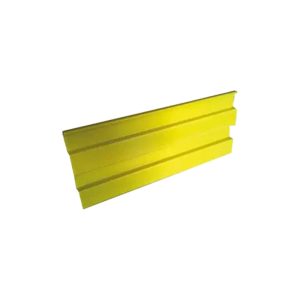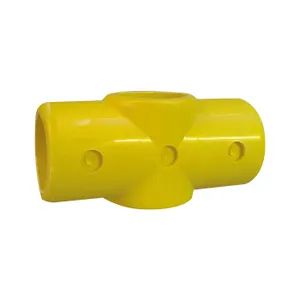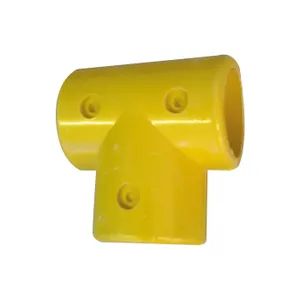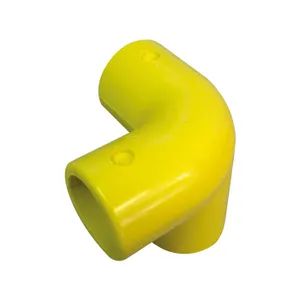Notre système de main courante en PRV est souvent utilisé dans une main courante ou un garde-corps en PRV pour continuer le rail intermédiaire sur un angle à 90° ou connecter des poteaux verticaux au rail supérieur, ou pour joindre le rail intermédiaire au poteau d'extrémité.
Présentation des performances du produit
|
|
Le pivot externe GRP est un raccord pivotant en ligne polyvalent, souvent utilisé là où les angles varient sur les pentes, les marches et les paliers. |
|
Le GRP 116 Mid Corner est un joint d'angle à 90°, souvent utilisé dans une main courante ou un garde-corps en GRP pour continuer le rail central sur un angle à 90°, mais peut également être utilisé pour construire des structures rectangulaires ou carrées. Le montant passe verticalement à travers le raccord GRP. Souvent utilisé avec le coin supérieur GRP-128. |
|
|
Le té court GRP 101 est une connexion en té à 90°, généralement utilisée dans une main courante GRP pour connecter les poteaux verticaux au rail supérieur ou pour joindre le rail intermédiaire au poteau d'extrémité. Le tube ne peut pas être joint dans la partie supérieure du raccord - le té long GRP-104 peut être utilisé comme alternative si cela est nécessaire. |
|
Le GRP Fitting 119 Midrail Cross est un joint à 90°, souvent utilisé pour joindre le rail intermédiaire à un poteau vertical intermédiaire dans une main courante ou un garde-corps en GRP. Le montant passe verticalement à travers le raccord GRP. |
|
|
Le Té long GRP 104 est une connexion en T à 90°, généralement utilisée pour connecter des poteaux verticaux au rail supérieur d'une main courante GRP. Le GRP -104 peut être utilisé lorsque deux longueurs de tube doivent être jointes dans la partie supérieure du raccord. |
|
Le raccord GRP 125 est un coude à 90°, souvent utilisé dans une main courante ou un garde-corps GRP pour relier le rail supérieur au poteau vertical à la fin d'une course. |
|
|
Le GRP 129 est un raccord en T à 30°, souvent utilisé dans une main courante ou un garde-corps en GRP d'escalier. |
|
La ferrure 128 Top Corner est à 3 voies. Coude à 90°, généralement utilisé pour joindre un poteau vertical au rail supérieur d'une main courante en PRV sur un coin à 90°. Souvent utilisé avec le GRP-116 Mid Corner. |
|
|
Le GRP 130 est une croix à 30°, souvent utilisée pour relier la traverse médiane aux poteaux intermédiaires dans une main courante en GRP d'escalier. |
|
Le GRP 116 Mid Corner est un joint d'angle à 90°, souvent utilisé dans une main courante ou un garde-corps en GRP pour continuer le rail central sur un angle à 90°, mais peut également être utilisé pour construire des structures rectangulaires ou carrées. Le montant passe verticalement à travers le raccord GRP. Souvent utilisé avec le coin supérieur GRP-128. |
|
|
La plaque de base GRP 132 est une bride de base avec quatre trous de fixation, utilisée pour fixer les poteaux verticaux dans une main courante ou un garde-corps. |
|
Le GRP 173 Single Swivel est un raccord pivotant polyvalent, utilisé là où les angles varient sur les pentes, les marches et les paliers. |
|
|
La prise murale 145 est un raccord en PRV conçu pour fixer latéralement les mains courantes ou les garde-corps en PRV aux murs, rampes et marches. |  |
Notre plaque de protection GRP a une largeur de 100 mm et une paroi de 5 mm. Il est stocké en longueurs de 6 m mais peut être coupé à longueur si nécessaire. |
Fabriqué en Chine en plastique renforcé de verre (GRP), le système de main courante GRP de TFcomposite offre des avantages clés par rapport à l'acier qui expliquent pourquoi vous verrez des mains courantes GRP partout, des usines de traitement de l'eau à l'industrie ferroviaire.
Fiberglass Reinforced Plastic (FRP) handrail systems are advanced, durable solutions for safety and access in industrial, commercial, and architectural applications. They are valued for their strength, corrosion resistance, and low maintenance, making them ideal for environments where traditional materials like steel or wood might fail due to exposure to harsh elements. Below is an in-depth exploration of FRP handrail systems, their components, benefits, applications, installation processes, and maintenance.
1. What is an FRP Handrail System?
An FRP handrail system is a modular or pre-engineered safety barrier system made from fiberglass reinforced plastic, a composite material that combines strong fibers with a polymer matrix. This results in a product that is lightweight, strong, and resistant to corrosion, chemicals, and UV exposure.
Key Components
FRP handrail systems typically consist of:
- Rails: The horizontal components providing continuous support.
- Posts: Vertical elements anchored to the ground or structure to support the rails.
- Knee Rails: Secondary horizontal rails for additional support and safety.
- Toe Boards: Base-level components to prevent tools or debris from falling.
- Raccords: Connectors, brackets, and fasteners that hold the system together.
- Bases and Mounts: Used to anchor the system to floors, walls, or other surfaces.
2. Materials and Manufacturing
FRP handrail systems are produced using two main manufacturing methods:
- Pultrusion:
- Continuous fibers are pulled through a resin bath and a heated die.
- Ensures uniform strength and a smooth finish.
- Moulage:
- Fiberglass mats or woven roving are layered and infused with resin in a mold.
- Often used for complex or custom shapes.
Common Materials in FRP Handrails
- Fibers: Typically glass fibers for high tensile strength.
- Types de résine:
- Polyester: Cost-effective and moderately resistant to chemicals.
- Ester vinylique: Higher resistance to chemicals and heat.
- Époxy: Superior mechanical strength and adhesion.
Additives like UV inhibitors, fire retardants, and pigments can be incorporated to enhance performance and aesthetics.
3. Key Benefits of FRP Handrail Systems
FRP handrail systems offer several advantages over traditional materials:
3.1. Résistance à la corrosion
- Ideal for environments exposed to chemicals, saltwater, or moisture.
- Used in wastewater plants, marine applications, and chemical processing facilities.
3.2. Lightweight and Easy Installation
- Weighs significantly less than steel or aluminum, reducing transportation and labor costs.
- Modular designs often allow for easy assembly without specialized tools.
3.3. High Strength-to-Weight Ratio
- Provides comparable or superior strength to traditional materials with less bulk.
3.4. Durability and Longevity
- Resists cracking, warping, and degradation over time.
- Long service life even in extreme conditions.
3.5. Low Maintenance
- Requires no painting or frequent inspections.
- Resistant to rust and biological growth.
3.6. Electrical and Thermal Insulation
- Non-conductive, making it safe for electrical environments.
- Low thermal conductivity reduces the risk of burns in high-temperature areas.
3.7. Customizability
- Available in various colors, sizes, and configurations to suit specific requirements.
- Aesthetic options enhance compatibility with architectural designs.
4. Applications of FRP Handrail Systems
FRP handrails are used across diverse industries due to their adaptability and robust properties. Below are examples of key application areas:
4.1. Installations industrielles
- Usines chimiques: Withstand chemical splashes and fumes.
- Oil and Gas: Non-corrosive properties ensure longevity in offshore and onshore facilities.
- Centrales électriques: Non-conductive properties provide safety in electrical substations.
4.2. Water and Wastewater Treatment Plants
- Resistant to chlorine, acids, and moisture.
- Ideal for walkways, platforms, and tank access.
4.3. Marine and Coastal Environments
- Unaffected by saltwater corrosion.
- Used on docks, piers, and offshore platforms.
4.4. Public Infrastructure
- Bridges, parks, and pedestrian walkways where safety and aesthetics are essential.
4.5. Commercial and Residential
- Balconies, staircases, and ramps requiring modern, low-maintenance railings.
5. Design Standards and Compliance
FRP handrail systems are often designed to meet rigorous safety and engineering standards, including:
-
OSHA (Administration de la sécurité et de la santé au travail):
- Ensures compliance with workplace safety guidelines for handrails.
- Requires specific height, strength, and deflection properties.
-
ASTM (American Society for Testing and Materials):
- Provides testing standards for strength, durability, and material performance.
-
ISO (International Organization for Standardization):
- Covers quality and environmental safety standards globally.
-
ADA (Americans with Disabilities Act):
- Mandates handrail accessibility features, such as smooth surfaces and appropriate height.
6. Installation of FRP Handrail Systems
Installing an FRP handrail system involves the following steps:
6.1. Preparation
- Assess site conditions and ensure the surface is clean and level.
- Mark installation points based on a pre-approved layout or engineering design.
6.2. Assembly
- Install base mounts or brackets at marked points.
- Attach posts to the base mounts using bolts or adhesives.
- Secure horizontal rails and knee rails to the posts using brackets and fasteners.
- Attach toe boards if required.
6.3. Finishing
- Tighten all connections and inspect for alignment.
- Apply sealants or coatings if additional protection is needed.
6.4. Safety Testing
- Perform load tests to ensure compliance with safety standards.
- Inspect for any loose connections or misalignments.
7. Maintenance of FRP Handrail Systems
FRP systems require minimal upkeep, but periodic checks can ensure maximum performance:
7.1. Cleaning
- Use mild soap and water to remove dirt, debris, or grease.
- Avoid abrasive materials to prevent surface scratching.
7.2. Inspection
- Check for loose fittings, bolts, or cracks in the material.
- Inspect joints and connections regularly.
7.3. Repairs
- Damaged components can often be replaced individually without dismantling the entire system.
- Use compatible adhesives or replacement parts from the manufacturer.
8. Customization Options
FRP handrail systems are highly customizable, allowing for adaptation to specific needs:
- Couleurs: Yellow, green, grey, or custom colors for branding or safety coding.
- Tailles: Varying rail diameters and post heights to meet specific requirements.
- Surface Finishes:
- Smooth for aesthetic purposes.
- Textured for slip resistance.
9. Cost Considerations
While the initial cost of FRP handrails may be higher than traditional materials, their long-term cost-effectiveness makes them an attractive option. Key cost factors include:
- Material grade (polyester vs. vinyl ester).
- Customization requirements.
- Installation complexity.
- Quantity and scale of the project.
10. FRP Handrail System vs. Traditional Materials
| Fonctionnalité | FRP Handrails | Steel Handrails | Aluminum Handrails |
|---|---|---|---|
| Résistance à la corrosion | Excellent | Pauvre | Modéré |
| Lester | Poids léger | Lourd | Poids léger |
| Entretien | Faible | Haut | Modéré |
| Force | Haut | Très haut | Modéré |
| Conductivité électrique | Non conducteur | Conducteur | Conducteur |
| Cost (Initial) | Moderate to High | Low to Moderate | Haut |
| Cost (Lifetime) | Faible | Haut | Modéré |
11. Future Trends
- Enhanced Aesthetics: New pigments and coatings for modern designs.
- Durabilité: Use of recycled or eco-friendly resins.
- Smart Systems: Integration of IoT sensors for safety monitoring.
Conclusion
FRP handrail systems are a superior choice for industries and environments requiring durability, safety, and low maintenance. Their adaptability and performance advantages over traditional materials make them a long-term investment for infrastructure and industrial facilities. By leveraging their modular design, ease of installation, and customization capabilities, FRP handrails continue to gain prominence in diverse applications.
Aperçu détaillé des systèmes de garde-corps en PRV
Série :
Principaux produits >application
Notre système de main courante GRP est largement utilisé dans la connexion transversale multi-drop-and-continue de la main courante et du garde-corps GRP.
Marque :
TFcomposite
Couleur :
jaune ou gris
FAQ
Q :
Quelle est la taille et la longueur du tube de main courante GRP ?
UN :
Le tube GRP n'est produit qu'en 50 mm de diamètre extérieur (diamètre extérieur) et est stocké en longueurs de 5 m. Nous pouvons couper le tube à longueur si nécessaire.
Q :
Comment les raccords sont-ils fixés au tube ?
UN :
Les raccords pour les mains courantes en PRV sont fournis sous forme de deux moitiés identiques qui se serrent simplement ensemble autour du tube. Ceux-ci doivent être percés sur place à l'aide d'un foret HSS standard de 9 mm de diamètre (fourni avec votre commande) et boulonnés avec les fixations spéciales en acier inoxydable fournies. Les boulons sont ensuite insérés et serrés à l'aide d'un tournevis pozi 3, la fixation de l'écrou moleté tiendra en place pendant le serrage du boulon. Ces fixations offrent une finition affleurante sans têtes de boulons saillantes.
Q :
Quelles sont les couleurs disponibles pour les systèmes de mains courantes en PRV ?
UN :
Nous stockons le tube et les raccords en jaune – pour une haute visibilité – ou en gris.
Autres produits connexes

























